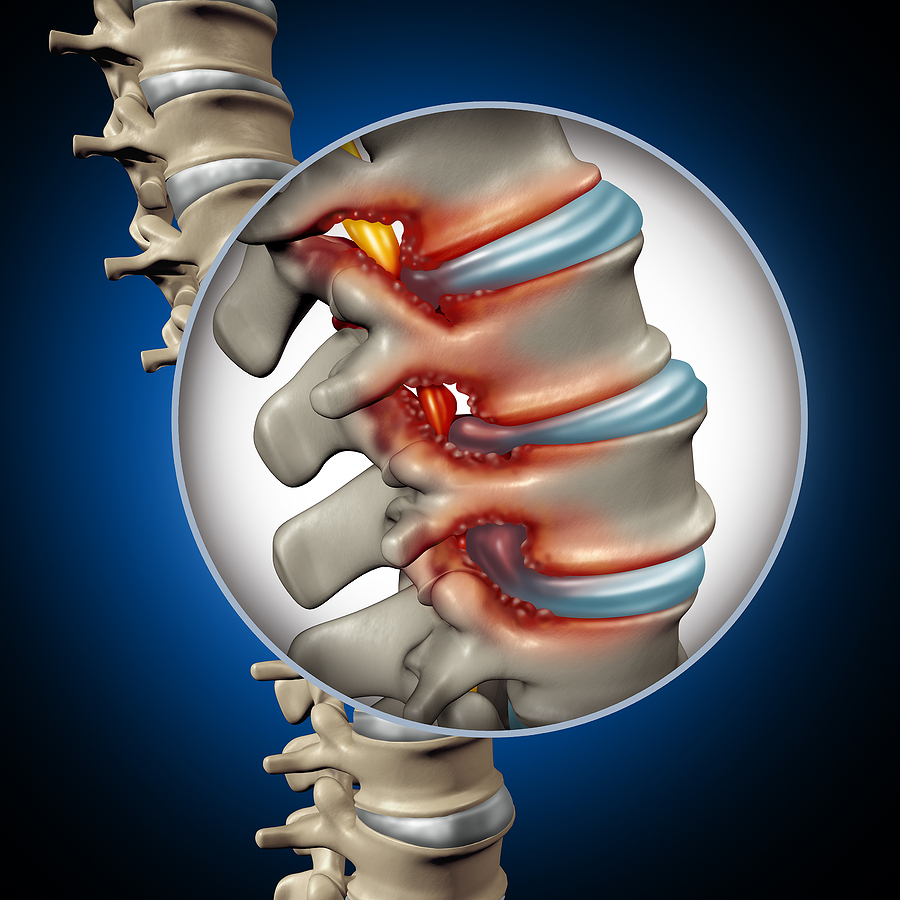What is Spinal Stenosis?
Generally, your spinal column slightly narrows over time with age. In most individuals, this gradual change leads to almost no serious complications. However, for some individuals, it can become a serious condition with painful and debilitating symptoms. As the space in between the spinal discs narrows, it can create pressure on the spinal cord and nerve roots. Spinal Stenosis is often classified by chronic lower back pain that fades as you bend or lean forward. This pain can also make it difficult to remain standing or sitting for long periods of time.

What Causes Spinal Stenosis?
There is a canal within your spine where the spinal cord sits. The spinal cord connects your brain to the rest of the body through the branches of the nervous system. Your vertebrae and spinal discs surround the canal to help protect it. However, the spinal discs tend to shrink as we age, causing pinching and pressure on the spine and nerves.
Additionally, other medical conditions can cause spinal stenosis. These conditions can include:
- Bulging/herniated discs
- Bone spurs
- Scoliosis & Kyphosis
- Osteoarthritis
- Scar tissues
Spinal stenosis can affect one or more regions of the spine. There are four sections of the spine. Listed from top to bottom, they are the Cervical spine, Thoracic spine, Lumbar spine, and Sacrum & coccyx. Most commonly, stenosis occurs within the lumbar and cervical spines. This means that it most commonly affects the areas of the neck or the lower back. If you require surgery to relieve your stenosis, you will likely be disabled for 6 months to a year while you recover.
What are the Debilitating Symptoms of Spinal Stenosis?
Depending on what part of your spine is affected, and how severe it is, you may experience a number of painful symptoms. Some of the more common symptoms may include:
- Back pain
- Burning pain or ache that radiates down the legs
- Pain that worsens as you sit or stand, but gets better with flexion
- Pinched nerves
- Weakness or cramping in the legs and feet
- Numbness or tingling in the legs and feet
Spinal Stenosis in the neck may also include the following symptoms:
- Neck pain
- Radiating numbness down the arms and into the hands
- Weakness in the arms and hands
Additionally, in more severe cases, individuals may experience problems with their bowels, bladder, or sexual functions.
Treatment Options for Spinal Stenosis
In most cases, surgery is not the first choice for most doctors. Generally, treatment options begin with the prescription of NSAID pain relievers, chiropractic decompression, and/or physical therapy. If your symptoms are severe and persistent enough, your doctor may recommend a surgical consultation. There are three types of surgeries for reducing spinal stenosis.
Laminectomy
A Laminectomy is a common procedure for reducing spinal pressure. The surgeon removes a portion of the vertebrae causing the pressure in order to provide room. The surgeon will also remove bone spurs that may have formed on the vertebrae. This gives the nerves and spinal cord enough room to function normally.
Foraminotomy
A Foraminotomy procedure expands the foramen of affected vertebrae. The foramen is a small hole that lets the root nerves leave the spinal column. The nerves can then avoid being pinched by the spine.
Spinal Fusion
During a Spinal Fusion procedure, the surgeon fuses 2 or more vertebrae together to help restore the spine’s natural curvature. The fusion is usually done with bone grafts, metal rods, or screws. The bones then grow together over time, providing a rigid structure.
Surgery Recovery
Recovery time for any of the 3 procedures above will generally range from six months to a year or more. You may also need time for physical therapy during your recovery period. During this time, you will likely be considered disabled and unable to work.
How Do Insurance Companies Look At Spinal Stenosis?
Long-term disability insurance companies will usually look at how your stenosis affects your ability to sit, stand, or walk. If you have a sedentary job, your insurance company will want to see if you can tolerate sitting at your desk for the majority of the day. Talk with your doctor about recommended lengths of sitting time, and how long you should stay sitting throughout the day. They may be able to give you an assessment that can provide the insurance company with a better understanding of your condition.
For jobs that require you to be on your feet more, your doctor can assess the amount of time you can stand or walk for. They may also give you an amount of time you should stay on your feet for.
Overall, the doctor’s assessment can be important in determining if you require disability coverage, and when you are able to return to work towards the end of your surgery recovery period.
Can an Attorney Help Me Get Long-Term Disability for Spinal Stenosis?
If you are looking to file a long term disability claim for your Spinal Stenosis, you should seek out an experienced attorney. At D’Agostino & Associates, we help people living with disabling conditions such as spinal stenosis file long-term disability claims. We help you through the process step by step to help you build a strong case. Our law team is here for you.
At D’Agostino & Associates, our team of lawyers can help you sort through all the details, understand what you are entitled to, and fight to get what you deserve. D’Agostino & Associates P.C. has offices in New York and New Jersey. Contact us, or call us at 1-888-245-2924 to schedule a free consultation with our attorneys.
